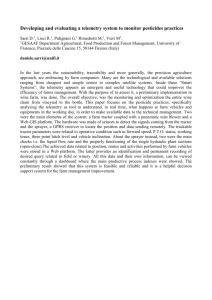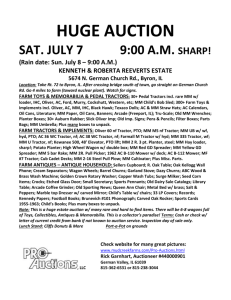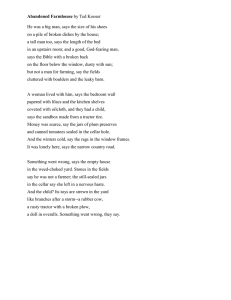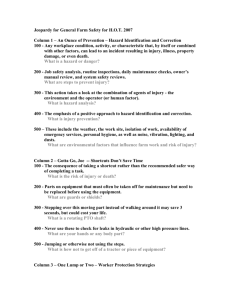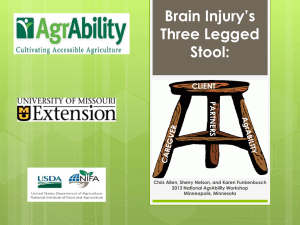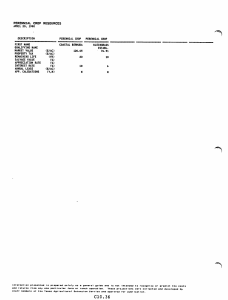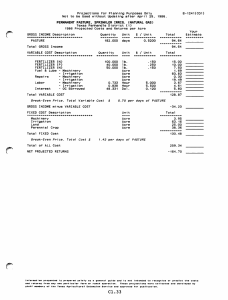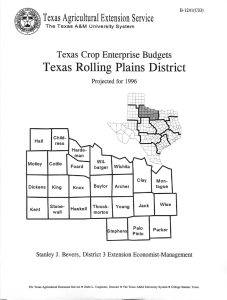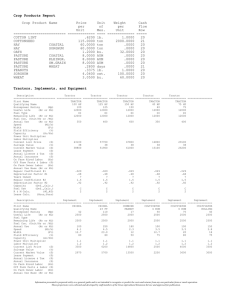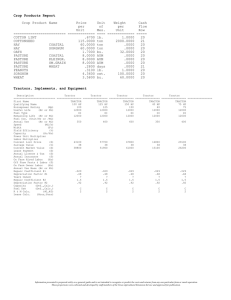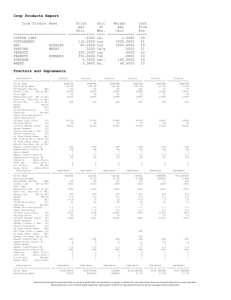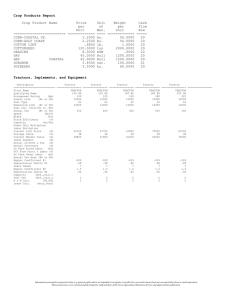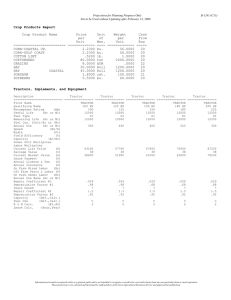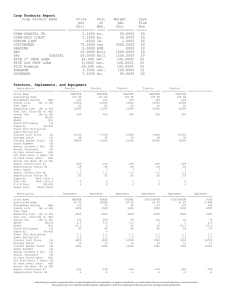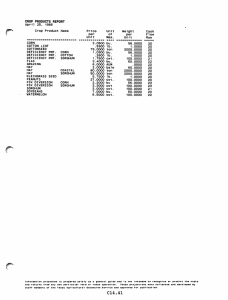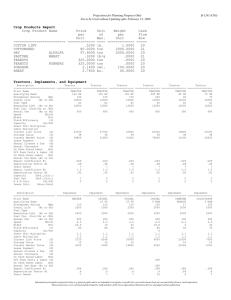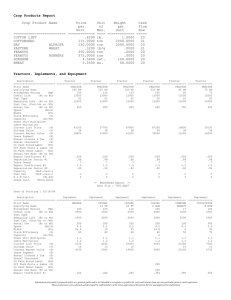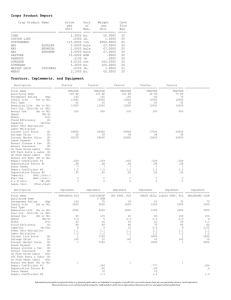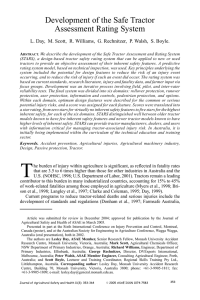OT assessment cont. - For Your Information
advertisement
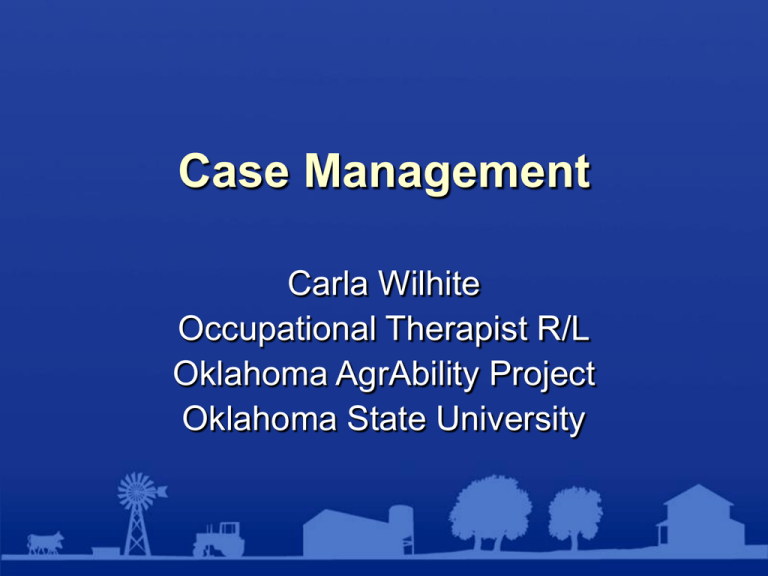
Case Management Carla Wilhite Occupational Therapist R/L Oklahoma AgrAbility Project Oklahoma State University Principles of Service Delivery • Informed choice. • Confidentiality • Client centered planning Ethical principles to follow • Beneficence. • Do good. • First, do no harm. Coordination of Case Management Service Delivery • • • • • • • Assessment Planning Implementing Coordinating, again and again Monitoring Re-evaluation Revise plan or “discharge” Assessment • Intake: Preliminary information used to determine eligibility for services or referral to others for service. • Assessment: Observing and analyzing the barriers the person is facing in the farm or ranch operation. May involve just an interview or specific functional tests, measurements, etc. Intake • Must be farming or wanting to farm. • Must have a disability. • Must need accommodations Definition of farming: • Broadly defined as cultivating, operating, or managing a farm for profit. A farm can include raising stock for food or fiber, dairy, poultry, fish, fruit, produce, orchards, providing range or pasturage, growing and harvesting forages, crops, grains, and aghorticultural products. Farmers • A farmer is defined as a person who is: Actively engaging in farming Deriving income from such activity Or retired from farming. For AgrAbility purposes: includes people who want to work in agriculture and family members of farmers. Definition of disability • A disability is identified as a physical or mental impairment that substantially limits a major life activity. A “substantial impairment” is one that significantly limits or restricts a major life activity; such as hearing, seeing, performing tasks, walking, caring for oneself, learning, or working. Accommodations Modifications to the work environment Accessibility issues Job re-structuring Modified work schedule Modified equipment Assistive technologies or adaptive devices. Assessment • Styles of assessment: Interview Observations Testing and measurement Eclectic (elements of all three) Assessment: “OT Style” • OT Bag: Blood-pressure cuff and stethoscope Pulse-oximeter Strain gauge Dynamometer Goniometer Disc-criminator • • • • • • • 9-hole peg board Tuning forks Heat/cold tubes Tape measure Digital camera Gait belt Resuscitation mask Assessment: “OT Style” • Functional assessment: Health history, previous level of function, pulse, respiration rate, O2 sat, blood pressure, medications. Manual muscle testing (upper and lower) Hand function (prehension, fine motor, gross motor) Functional assessment cont. • Sensory evaluation (vision, hearing, touch, smell, taste) • Posture and postural deviations • Gait and balance • Pain scale OT assessment cont. • Activities of daily living: self-care, work, communication, driving status, leisure, etc. • Home safety: trip hazards, clutter, bathroom safety equipment, electrical cords and plugins, fire alarms, fire extinguishers, emergency egress, etc. OT assessment cont. • Psycho-Social assessment: Adjustment: grief, anger, acceptance Depression, anxiety, suicidality Adaptability: flexible vs. rigid Evidence of motivation Financial position or stressors Social support Community participation OT assessment cont. • Work-site: Environmental conditions Building access Workbenches Equipment access Seating in agricultural machinery Terrain Fences/gates Tools OT assessment cont. • Miscellaneous: Cognitive assessment Visual-perceptual assessment Use of time worksheets Depression scale Other assessment tests as needed Reporting: Report should be ability focused, not deficit focused. Organized in an understandable format: Intro, assessment, findings, recommendations, plan Reporting: • Uses of the report: For goal-setting. For making referrals. For staying focused on the plan. For “persuasion” of third party payers or funding sources. Planning: Goal-setting and prioritization of goals • Goal-setting: Client-centered goals/functional goals • Versus Organizational goals • All goals should be RUMBA: Relevant,Understandable,Behavioral,and Achievable Client- centered goal • Goal: Farmer John will demonstrate the ability to safely drive a tractor with hand control modifications. • Objectives: John will verbalize understanding the types of hand control adaptations available for agricultural machinery. John will acknowledge the pros and cons of commercial adaptations vs. local fabrication of controls. John will choose the hand control modifications needed for his tractor. John will select a strategy for financing hand controls. John will arrange for installation of devices to control the tractor. John will seek appropriate guidance or teaching for using hand controls to operate his tractor. • Activities: Provide John with information on hand controls for operating tractors. Provide John with information on liability, pros/cons of locally fabricated solutions. Discover possible sources for local fabrication and commercial fabrication. Discuss financial resources for paying costs of hand controls (self-pay, DRS, combination of sources) Provide examples of a standard of safe operation of tractor. Driving instruction? Implementing the Plan • Assisting the client as they enter vast bureaucratic systems and making sure they come out alive on the other end. • Providing reliable information on which to make decisions. • Assist in putting together the right array of resources. Know your resources: • Continuous and ongoing activity to locate and be able to refer people to the right agencies, services, etc. Coordinating • • • • • Phone calls “Checking in” Facilitating decision-making Advocating Tasking others Monitoring • How is it going as changes are implemented? Tweak, tweak, tweak as needed Re-evaluation • Are the goals met? If not, why? • Are new needs identified? • Or is it time for closure? Send satisfaction survey or conduct interview? Document outcomes. Two Best Practice Tips • Become a master of observation: Verbal and non-verbal communiction Function, function, function • Focus on what the individual wants and needs (client-centered), not on what you see they need (expert-centered). • Recognition: This material is partially based on the training module in Case Management developed by Mary Beck, National AgrAbility Staff

